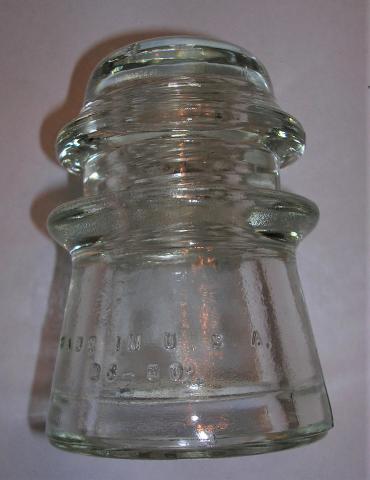HEMINGRAY - 16 & 17 (Mold # 26, 1953) In the early days of the telephone, single petticoat insulators were standard for toll line construction. The Hemingray No. 16, with a single petticoat is still widely used for lines of medium length. The No. 16 has about the longest leakage path possible for a single petticoat type on a standard pin. It has a square wire groove. The No. 17 is exactly similar to the No. 16 except it has a somewhat wider groove for larger wire. Hemingray was founded by Robert Hemingray and Ralph Gray in 1848 and had factories in Cincinnati and Covington, Kentucky along with its main factory in Muncie, Indiana built in 1870. Along with insulators, Hemingray produced other glass ware products for industrial use. In 1933, the company was purchased by the Owens-Illinois Glass Company, which continued to produce the Hemingray products under the Hemingray brand. Telegraphs were first introduced to Iowa in 1848 with a line connecting Dubuque, Keokuk, Burlington, Bloomington (Muscatine), Iowa City, and Davenport, Iowa to Peru, Illinois. By 1861, two telegraph companies were responsible for the Iowa lines, Western Union Telegraph Company and the Illinois & Mississippi Telegraph Company. Western Union Telegraph was also responsible for the earliest telephone lines introduced to Iowa with the first exchange being built in Keokuk, Iowa in 1878 along with exchanges in Des Moines, Davenport, and Ottumwa. Western Union would sell to the Bell Company in 1879 and Bell would construct its first exchange in Dubuque in the same year. Bell Company would establish several smaller companies to aid in the management of the Telephone lines including Hawkeye Telephone, Iowa Union Telephone, and Iowa & Minnesota Telephone. Hawkeye Telephone established the telecommunications in Cedar Falls and Waterloo Iowa in 1881. For any use other than instructional resources, please check with the organization that owns this item regarding copyright restrictions.
2018.018.094 [Insulator, Communication]
Legal Status
Ownership of this resource is held by the Cedar Falls Historical Society and has been provided here for educational purposes only, specifically for use in the Iowa Museum Association's "Teaching Iowa History" project. It may not be downloaded, reproduced or distributed in any format without written permission from the Rights Holder. For information on U.S. and International copyright laws, consult an attorney.

